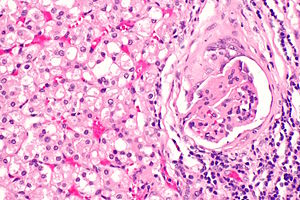Succinate dehydrogenase-deficient renal cell carcinoma
Jump to navigation
Jump to search
| Succinate dehydrogenase-deficient renal cell carcinoma | |
|---|---|
| Diagnosis in short | |
 SDH-deficient renal cell carcinoma. H&E stain. | |
|
| |
| LM | eosinophilic cells with clear (flocculent) cytoplasmic inclusions, round nuclei with mildly granular chromatin pattern, intratumoural mast cells, solid architecture |
| LM DDx | renal oncocytoma, chromophobe renal cell carcinoma, clear cell renal cell carcinoma, other renal tumours with eosinophilic cytoplasm |
| IHC | SDHB -ve, CK7 -ve, CD117 -ve, PAX8 +ve |
| Gross | mass lesion, commonly cystic |
| Site | kidney - see kidney tumours |
|
| |
| Syndromes | familial pheochromocytoma and renal cell carcinoma syndrome |
|
| |
| Prevalence | extremely rare |
| Prognosis | usually good prognosis (limited data) |
| Clin. DDx | other kidney tumours |
Succinate dehydrogenase-deficient renal cell carcinoma, also succinate dehydrogenase renal cell carcinoma (abbreviated SDH-RCC), is a very rare type of renal cell carcinoma.
It is grouped in the emerging entities of the Vancouver modification of the 2004 WHO classification of renal neoplasia.[1]
General
- Extremely rare - estimated to represent up to 0.2% of renal cell carcinomas.[2]
- May be assocated with paraganglioma and familial, as with several SDH mutations.[3]
- Primarily described with a SDHB mutation.[4]
- Usually good prognosis.
Gross
- Mass lesion - commonly cystic.
Microscopic
Features:[4]
- Eosinophilic cells with clear (flocculent) cytoplasmic inclusions. ‡
- Round nuclei with mildly granular chromatin pattern.
- Intratumoural mast cells - usu. not prominent.
- Solid architecture - typical.
Notes:
- ‡ Occasional cells may look like signet ring cells.
- Typically low ISUP nucleolar grade.
- May be sarcomatoid.
DDx:
- Renal oncocytoma - granular cytoplasm.
- Chromophobe renal cell carcinoma.
- Clear cell renal cell carcinoma.
- Other renal tumours with eosinophilic cytoplasm.
Images
www:
- SDHB-RCC - poor quality histology image (nih.gov).[5]
- SDHC-RCC (nih.gov).[5]
- SDH-deficient RCC (nature.com).[4]
Case 1
Case 2
IHC
Features:
- SDHB -ve (11 of 11 cases[4]).
- Normal tubules +ve.
- May be (pseudo)negative in clear cells (as few mitochondria).
- CD117 -ve - important.
Others:
See also
References
- ↑ Srigley, JR.; Delahunt, B.; Eble, JN.; Egevad, L.; Epstein, JI.; Grignon, D.; Hes, O.; Moch, H. et al. (Oct 2013). "The International Society of Urological Pathology (ISUP) Vancouver Classification of Renal Neoplasia.". Am J Surg Pathol 37 (10): 1469-89. doi:10.1097/PAS.0b013e318299f2d1. PMID 24025519.
- ↑ Gill, AJ.; Hes, O.; Papathomas, T.; Šedivcová, M.; Tan, PH.; Agaimy, A.; Andresen, PA.; Kedziora, A. et al. (Dec 2014). "Succinate dehydrogenase (SDH)-deficient renal carcinoma: a morphologically distinct entity: a clinicopathologic series of 36 tumors from 27 patients.". Am J Surg Pathol 38 (12): 1588-602. doi:10.1097/PAS.0000000000000292. PMID 25025441.
- ↑ Hernandez, KG.; Ezzat, S.; Morel, CF.; Swallow, C.; Otremba, M.; Dickson, BC.; Asa, SL.; Mete, O. (Mar 2015). "Familial pheochromocytoma and renal cell carcinoma syndrome: TMEM127 as a novel candidate gene for the association.". Virchows Arch. doi:10.1007/s00428-015-1755-2. PMID 25800244.
- ↑ 4.0 4.1 4.2 4.3 4.4 4.5 4.6 Williamson, SR.; Eble, JN.; Amin, MB.; Gupta, NS.; Smith, SC.; Sholl, LM.; Montironi, R.; Hirsch, MS. et al. (Jan 2015). "Succinate dehydrogenase-deficient renal cell carcinoma: detailed characterization of 11 tumors defining a unique subtype of renal cell carcinoma.". Mod Pathol 28 (1): 80-94. doi:10.1038/modpathol.2014.86. PMID 25034258. Cite error: Invalid
<ref>tag; name "pmid25034258" defined multiple times with different content - ↑ 5.0 5.1 5.2 Ricketts, CJ.; Shuch, B.; Vocke, CD.; Metwalli, AR.; Bratslavsky, G.; Middelton, L.; Yang, Y.; Wei, MH. et al. (Dec 2012). "Succinate dehydrogenase kidney cancer: an aggressive example of the Warburg effect in cancer.". J Urol 188 (6): 2063-71. doi:10.1016/j.juro.2012.08.030. PMID 23083876.
External links
- Succinate dehydrogenase-deficient renal carcinoma (cancerdxpathology.org.au) - virtual slides from Gill.







